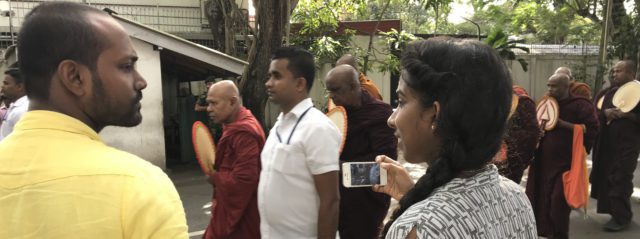
SO WHAT DO PEST CONTROL IN INDONESIA, A PRESIDENTIAL ELECTION IN UKRAINE AND 250 BUDDHIST MONKS IN SRI LANKA HAVE IN COMMON?
No, this is not the beginning of a standup routine from 1976. This is proof, of a digital world where the barriers of video production, are declining.
For the last ten years, I have been writing a lot about the revolution in digital technology. With modern smartphones we can shot, edit and broadcast. This is important, because it gives so much freedom, to both our commercial and traditional media clients. However, while there has been a great deal of talk over the past decade – in all honesty – I have seen little evidence of good quality content being produced.
Yes, people have been using their smartphones to make videos – but in my experience, most of it is rubbish. It’s badly shot, poorly edited and fails to follow any form of storyline or narrative.
But in the past couple of months, a number of things happened to change my mind:
- It began with a discussion about a project I’m working on in Kiev. We are creating a multi-media newsroom for the Ukrainian TV station UA:PBC. They want to launch a new platform, in time for the presidential elections in March 2019. We said why not pick up two computers and mobile phones, and start from there. They did – and now they have a fully operational digital team, dedicated to covering the election. Simples.
- The second was at a meeting in San Diego. It was with a team of pest control experts. We have been helping develop a campaign, highlighting how the company is combatting the problem of flies and pests, on chicken farms in Indonesia. Yes, we are that glamorous. We ran a workshop for them in January. During it, we taught the power of video storytelling. Six months later, they are producing some really high quality, engaging content with local farmers.
- The third example came last month. I was in Sri Lanka, with a newspaper group, which is evolving into a multi-media, digital platform. I went out with one of the reporters. Dinusha is newspaper journalist. She’s trained in writing, not filming. With a few simple pointers and a bit of direction, she shot an entire video, on a protest march by 250 Buddhist monks.
None of this is revolutionary, but it highlights the importance on knowing what you are doing and how to tell a story in video. We think it illustrates a few key lessons;
- Understand the grammar of filmmaking. If you have training in the basic skills of video production you can create some really great content – but it is essential you have this knowledge.
- Identify the characters in any story. People care about people. If you can find an engaging person who can bring a story to life, you are close to success. The farmers in Indonesia and the Buddhist monks are great examples.
- Just do it. Why not give it a go. If you have an idea or a concept, try it out. Technology has given us a lot of freedom – take advantage of that.
As we have often stated, there is so much noise out there. So it’s essential you cut through this with powerful and creative video storytelling.
At 2020 Media International we work with a whole range of clients, from the BBC, to international news organisations and commercial clients, to do just this.